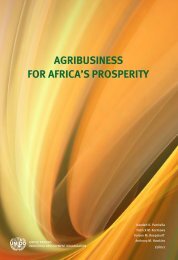Collection of Case Studies 2. - Seas of Change Initiative
Collection of Case Studies 2. - Seas of Change Initiative
Collection of Case Studies 2. - Seas of Change Initiative
You also want an ePaper? Increase the reach of your titles
YUMPU automatically turns print PDFs into web optimized ePapers that Google loves.
motorcycles. There are over 120 such small scale businesses around the market which <strong>of</strong>ficially pay taxes to thecounty council while there are about 300 businesses that operate in total; <strong>of</strong> which three quarters are involved inagri-business on any market day.Lastly, market information systems have been greatly improved. Previously, government <strong>of</strong>ficers used to travel tomarkets to report on market information, such as the number <strong>of</strong> livestock sold, at which prices etc. This was atime consuming process, as <strong>of</strong>ficers had to travel from market to market. This system is now run by youngpeople at the markets, who report the information by phone to a general system which collects data for all themarkets. Market information is thus much more accurate, and is more easily accessible. Data collection costsare just a fraction <strong>of</strong> the former collection process.The vibrancy <strong>of</strong> these markets has also ensured an all year round availability and access to food stuffs for thecommunity; with goods <strong>of</strong>ten transported to the market by the trucks that go to buy cattle or other animals.These trucks are now coming more <strong>of</strong>ten due to the fact that the markets are much more vibrant; subsequentlyaccess to food stuffs and food security has been greatly improved. This attracted the attention <strong>of</strong> the UN’s Foodand Agricultural Organization (FAO) in 2008/09, as it fitted in their approach to address food security issues, notthrough emergence aid but much more sustainably through market based actions. The FAO provided resourcesto five Non Government Organisations (NGOs) and local capacity builders to up-scale the model to other ASALcounties and further develop linkages between livestock BDS service providers and producers through thesemarkets. The services include the supply <strong>of</strong> fodder, water, financial services, agro-veterinary services andlivestock insurance.4. ImpactThe co-management model had spread to 21 locations by the end <strong>of</strong> 2011, benefiting about 80,000 householdsin seven counties. Based on the detailed data <strong>of</strong> four markets that can be considered as more or lessrepresentative <strong>of</strong> all 21, the following figures can be extrapolated a total 504,000 people are benefiting from themarkets 18 , with each market seeing around US$54,000 in turnover on a market day (i.e. for animals sold, and <strong>of</strong>business around the markets). Herders are selling their animals at prices 20-30% higher than before. The directincome gains for livestock owners are even higher, since there is also fewer losses and theft <strong>of</strong> animals. Inaddition, women and young people are gaining incomes as well.The councils, after sharing with the community, have been able to get almost similar amounts as before, but theircosts have reduced by more than 90 percent since the LMAs do all the work. Hence what the council gets is anet average <strong>of</strong> about US$18,750 per annum. 19 The LMAs have a similar income, due to the 50/50 division. Theyhowever have to cover operational expenses including market management and operations.The impact <strong>of</strong> the model illustrated by the example <strong>of</strong> Lolkuniani Market in Samburu County“Despites the inability <strong>of</strong> my husband to provide for the family due to age, I have been able to ensure my fourchildren go to school from this small business that has bloomed because <strong>of</strong> the vibrant livestock market”Mpanyoi Lenges, a local woman trader boasting <strong>of</strong> her success.The weekly market serves the entire population <strong>of</strong> Lolguniani which has an estimated 800 households. Thistranslates to a population <strong>of</strong> about 4,000 people with a monthly average <strong>of</strong> 10% (400) <strong>of</strong> the population activelyengaged with livestock trade on each market day. At its peak, an average <strong>of</strong> 2,000 goats worthy approximately€27,500 and cows worth €10,000 are sold per market day that is held once a week. This is in addition to thecamels and donkeys sold during market days. Prior to the project, people had to travel long distances to disposetheir animals, or they sold their cattle to middlemen at almost half their current prices.The following outcomes and impacts can be ascribed to the model:At community level: Most producers can now access the buyers directly without using brokers, who used to waylay themwhile they travelled to markets up to 200kms away. This has led to producers increasing their grossmargins by between 30-40% per cow/bull. Market information systems facilitate better negotiatingpositions for livestock owners, as they now have access to the prices <strong>of</strong> livestock all over the country byphone.18Based on the average support <strong>of</strong> a market <strong>of</strong> 4,000 households, with an average six people per household, times 21 markets.19About Kshs 30,000 x 50 market days a year = 150,000 Kshs.44







